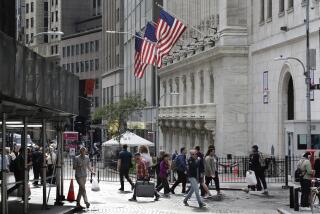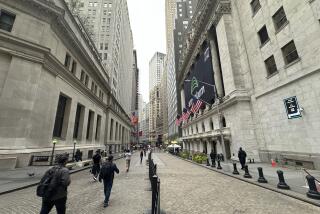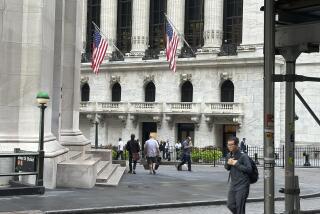Dow Dives 199 on Rate, Energy Fears
- Share via
Wall Street found itself double-teamed by the Federal Reserve chairman and an ayatollah on Monday, and the result was a rout.
The Dow Jones industrial average plunged nearly 200 points and small-stock indexes suffered their worst decline in more than three years after Iran warned it might cut off oil to the West and Fed chief Ben S. Bernanke said the trends in inflation were “unwelcome.”
The fresh round of selling stoked concern that the market’s slump hadn’t run its course, although broad stock indexes finished above their recent lows.
Stocks worldwide have been swinging wildly since mid-May on worries that rising inflation and interest rates could doom the global economic expansion. The Dow has suffered triple-digit point losses in five trading sessions since May 10.
Home builders, vulnerable to rising mortgage rates, have watched their shares skid for the last month. One broad index of the sector tumbled nearly 5% on Monday to a 19-month low.
Stocks began to slide at the outset of trading after Iran’s supreme leader, Ayatollah Ali Khamenei, said Sunday that the U.S. could “seriously endanger energy flow in the region” by acting against Iran. The Islamic Republic and the U.S. are at odds over Iran’s nuclear-technology development program.
But the market’s losses were relatively modest until Bernanke, speaking at a banking conference in Washington, said that inflation pressures in the economy were troubling the Fed and that the central bank “will be vigilant” to make sure higher inflation doesn’t stick.
John Caldwell, investment strategist at McDonald Financial Group in Cleveland, said that because Bernanke also said the economy was decelerating, he revived Wall Street’s worst fear -- that “growth is slowing and inflation is rising.”
That raises the risk that the Fed could go too far in tightening credit, driving the economy into recession, Caldwell said. “That is the overriding sentiment” weighing on stocks since mid-May, he said.
The Dow ended Monday at 11,048.72, down 199.15 points, or 1.8%.
The index hit a six-year high on May 10, when the Fed raised its key short-term interest rate for the 16th time since mid-2004. The market began to slide the next day in a delayed reaction to warnings from Fed policymakers that they might continue to lift rates to quash inflation.
The Dow is down 5.1% since that high point, and many broader market indexes have fallen more sharply. The technology-heavy Nasdaq composite, which slid 49.79 points, or 2.2%, to 2,169.62 on Monday, is down 8.5% from its five-year high reached April 19.
Selling accelerated in some sectors on Monday, suggesting that some investors rushed to bail out after shares couldn’t sustain the rebound that lifted prices late last week.
The Russell 2,000 small-stock index plummeted 23.53 points, or 3.2%, to 713.92, its biggest one-day loss since October 2002.
Losers outnumbered winners nearly 4 to 1 on the New York Stock Exchange and Nasdaq.
Still, some analysts said it was a good sign that most major indexes held above their May lows. The Standard & Poor’s 500 index, for example, finished at 1,265.29, down 22.93 points, or 1.8%, for the day but above its recent closing low of 1,256.58 on May 23.
The Russell 2,000 index’s recent low was 711.04 on May 30.
“I think the short-term story is that we’ve put in a bottom over the last two weeks,” said Ken Tower, market strategist at CyberTrader Inc. in Princeton, N.J.
The market’s turnabout on Monday, after last week’s rally, “is typical of market bottoms, because anxiety is high,” he said.
Although the slide in stock prices has wiped out much of the U.S. market’s gains for the year, the pullback hasn’t amounted to even a normal “correction” within a bull market, analysts note. Such corrections can shave 10% to 15% from key indexes before they stabilize.
Michael Holland, head of money management firm Holland & Co. in New York, said he saw no point in selling shares of blue-chip multinational companies such as 3M, which fell $1.83 to $82.95 on Monday.
“If anything, things outside the U.S. are starting to pick up,” he said of the global economy. That should benefit multinational firms’ earnings, he said.
Among Monday’s highlights:
* Khamenei’s warning helped push crude oil futures in New York as high as $73.84 a barrel, but the price retreated to end at $72.60, up 27 cents for the day.
Despite oil’s gain, energy-related stocks were among the day’s biggest losers. ConocoPhillips slid $1.97 to $62.54. Sunoco lost $2.65 to $68.29 and Apache fell $2.38 to $63.51.
Other commodity-related shares also sank, apparently on worries about the economy. Mining firm Rio Tinto plummeted $8.35 to $208.86. Steel maker Nucor lost $3.49 to $50.41.
* Yields rose in the Treasury bond market on uncertainty about how much further the Fed might tighten credit. The 10-year T-note edged up to 5.02% from 4.99% on Friday, when yields plunged after the government’s May employment report showed a slowdown in job creation.
* Among builders, KB Home slumped $2 to $49.10 and Ryland Group sank $4 to $45.50. The combination of slowing economic growth and rising interest rates could be particularly damaging for builders.
* Gold gained for a second session, adding $7.70 to $643.20 an ounce in New York.
More to Read
Inside the business of entertainment
The Wide Shot brings you news, analysis and insights on everything from streaming wars to production — and what it all means for the future.
You may occasionally receive promotional content from the Los Angeles Times.










